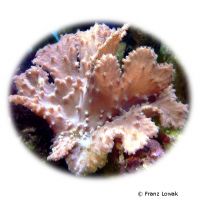Cabbage Leather Coral (Sinularia brassica)
| Cabbage Leather Coral Sinularia brassica | |
|---|---|
| Name | Cabbage Leather Coral |
| Name Lat. | Sinularia brassica |
| Family | Leather Corals |
| Family lat. | Alcyoniidae |
| Order | Soft Corals |
| Order lat. | Alcyonacea |
| Origin | Indo-Pacific |
| Diet | Autotrophic, planktivore |
| pH | 8.1-8.4 |
| Hardness | 8-12 °KH |
| Lighting | Medium - high |
| Current | Moderate - strong |
| Behavior | Semi-aggressive |
| Keeping | Colony |
| Care Level | Easy |
| Life Span | N/A |
| Protection | No |
| Metric Units | |
| Size | < 8 cm |
| Temperature | 24-28 °C |
| Salinity | 33-36 ‰ |
| Aquarium | 200 l |
| US Units | |
| Size | < 3.1" |
| Temperature | 75-82 °F |
| Salinity | 1.020-1.025 sg |
| Aquarium | 50 gal |
Distribution and habitat
The distribution range of Sinularia brassica extends from the Red Sea through the tropical Indian Ocean to the Central Pacific. They live in colonies preferably on outer reefs with strong currents down to medium depths.
Maintenance
They should be positioned in a location with moderate to high light intensity and moderate to strong alternating current
Only high-calcium, heavy metal-free substrates should be used as substrate. Filters, skimmers and heaters are necessary to ensure water quality, as well as pumps to simulate tides, swells and bottom currents. It is recommended that live stones be used to set up the aquarium. The bacteria living in the porous stones act as a biological filter. The lighting must correspond to the species-appropriate day-night rhythm of the animals
| Salinity: 33-36 ‰ | pH value: 8.1-8.4 |
| Carbonate hardness: 8-12 °KH | Nitrate content: 2-8 mg/l |
| calcium content: 420-450 mg/l | Nitrite content: 0.0-0.05 mg/l |
| Magnesium content: 1.250-1.350 mg/l | phosphate content: 0.01-0.1 mg/l |
Regular addition of trace elements, especially iodine and strontium, is recommended. For salinity, an average value should be aimed for, which may only vary slightly by +/- 0.5 ‰. Ammonia and ammonium must not be measurable. Special attention shall be paid to consistently good water quality and water values.
Diet
Zooxanthellae, which are unicellular symbiotic algae, live in their tissue and provide them with assimilation products of their photosynthesis (high light requirement). The zooxanthellae promote growth and provide additional food to the plankton and small particles collected from the water current. Thus, in addition to the food produced in the aquarium during fish feeding (mysis, krill, Artemia, etc.), commercial food for lower animals in the form of phyto- and zooplankton, frozen or liquid, should be offered regularly
Regular and varied feeding promotes health and prevents deficiency symptoms.
Behaviour and compatibility
They live in small colonies and can be well socialized with fish that do not consider them food. A sufficient distance to other corals must be kept, in order not to restrict them in their growth and to avoid a nettling.
Reproduction and breeding
Little is known about sexual reproduction. In the aquarium they can be propagated well by fragmentation (separation of tissue parts). The fragment is fixed on a piece of living rock, to which it grows after a few weeks.
Important
Their growth habit depends on the location. They "shed their skin" by sliming. With their mucus cells they form a thin, greenish shimmering "skin", which is removed by inflating and protruding the polyps in shreds. This removes pollution, such as sediment and algae, as well as parasites. The additional illumination with actinic light (short-wave, violet-blue light) is very beneficial for their growth (zooxanthellae).
For the necessary uniform supply of calcium carbonate and magnesium, a calcium reactor and a magnesium metering pump are recommended.
If different species are kept together, care should be taken to ensure that fish and invertebrates match each other in terms of water quality and temperature requirements, as well as their social behavior, and that the setup meets the ecological needs of all species kept together. Newly introduced animals must be acclimated slowly to the water in the aquarium.
Further literature can be found in your pet store.
References
Text: Werner Winter; Image: Franz Lowak
Source: ERHARDT & MOOSLEITNER (1997): Meerwasser Atlas Bd. 2, Mergus Verlag; ENGELMANN & LANGE (2011): Zootierhaltung - Tiere in menschlicher Obhut: Wirbellose, Verlag Harri Deutsch
